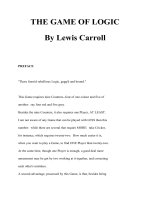The myths of innovation by scott berkun
Bạn đang xem bản rút gọn của tài liệu. Xem và tải ngay bản đầy đủ của tài liệu tại đây (3.58 MB, 248 trang )
Praise for The Myths of Innovation
Since its initial publication, The Myths of Innovation has been discussed
at or on NPR, MSNBC, CNBC, Yale University, MIT, Carnegie Mellon
University, Microsoft, Apple, Intel, Google, Amazon.com, as well as
other major media, corporations, and universities around the world.
“The naked truth about innovation is ugly, funny, and eye-opening—
but it sure isn’t what most of us have come to believe. With this
book, Berkun sets us free to try to change the world unencumbered
with misconceptions about how innovation happens.”
—Guy Kawasaki, author of The Art of the Start and
Rules for Revolutionaries
“Brimming with insights and historical examples, Berkun’s book not
only debunks widely held myths about innovation, it also points the
ways toward making your new ideas stick. Even in today’s ultra-
busy commercial world, reading this book will be time well spent.”
—Tom Kelley, GM, IDEO; author of The Ten Faces of
Innovation
“No word in the current business arena is more used with incorrect
applicability than the word innovation. Scott’s tome is understand-
able, thoughtful, often contrarian, and a great read.”
—Richard Saul Wurman, author of Information Anxiety;
creator of the TED conference
“Berkun unravels the misconceptions of where ideas come from with
wit, realism, and authority. This book will change the way you
think about invention—permanently.”
—Lifehacker.com
“It’s an easy read that is hard to put down. What’s more it’s really
motivating. After reading this book you will want to dig right back
into those crazy ideas.”
—Slashdot.org
“It’s an entertaining and thought-provoking read.”
—London Book Review
“A book that belongs on the same shelf with Thomas Kuhn, Howard
Gardner, and Eric Von Hippel, The Myths of Innovation will chal-
lenge your assumptions about the roots of breakthrough ideas, and
inspire you to come up with a few of your own.”
—Steven Johnson, author of The Ghost Map and
Everything Bad Is Good For You
“The Myths of Innovation is insightful, inspiring, evocative, and just
plain fun to read. And on top of that, it goes to the heart of innova-
tion and its many challenges. It’s totally great.”
—John Seely Brown, Former Director, Xerox Palo Alto
Research Center (PARC)
“Would-be trailblazers and worldchangers should stop waiting for
lightning to strike their laptops and study the wisdom Scott Berkun
has gathered instead. Methodically and entertainingly dismantling
the cliches that surround the process of innovation, Berkun reminds
us that there are no shortcuts to breakthroughs—and that creativity
is its own reward.”
—Scott Rosenberg, author of Dreaming in Code;
cofounder of Salon.com
“I love this book! Wise, witty, packed with fascinating history, com-
pelling anecdotes, and priceless ideas”
—Richard Farson, President, Western Behavioral Sciences
Institute; author of Management of the Absurd:
Paradoxes in Leadership
“Most of what business schools teach about innovation qualifies as
urban legend. This book is the remedy: a fun, smart tour of the
entrepreneurial spirit, in myth and reality.”
—William Poundstone, author of How Would You Move
Mount Fuji?
“Will inspire you to come up with breakthrough ideas of your own.”
—Alan Cooper, father of Visual Basic and author of
The Inmates Are Running the Asylum
“How I ran a startup without reading this book baffles the mind.”
—Richard Stoakley, CEO, Overcast Media, Inc.
“If you care about being innovative, whether for yourself, your com-
pany, or your students, you need to know where the truth lies—
what the myths are.
Scott Berkun’s book dispels the myths while providing solid advice
about the practice. All this in an eminently readable, enjoyable style
that delights as it informs. Small, simple, powerful: an innovative
book about innovation.”
—Don Norman, Nielsen Norman Group; author of
Emotional Design and The Design of Everyday Things
“This book cuts through the hype, analyzes what is essential, and
more importantly, what is not. You will leave with a thorough
understanding of what really drives innovation.”
—Werner Vogels, CTO, Amazon.com
“This book shatters the sacred cows of innovation myths and gives
real-world innovators insight into making innovations that matter.”
—Jim Fruchterman, CEO, Benetech; 2006 MacArthur Fellow
“Berkun shows us what innovation isn’t, challenging our precon-
ceived notions of what innovation means. Whether you agree or dis-
agree with Scott, this book will make you think.”
—Gary William Flake, PhD, Founding Director,
Microsoft Live Labs
“Mythology: innocent storytelling or damaging lies? Berkun looks into
innovation myths and reveals how they can damage true organiza-
tional creativity. He reveals the myths but also provides an incredibly
useful framework for going forward—this is an awesome book.”
—Tara Hunt, Founder, Citizen Agency
“‘The most useful way to think of epiphany is as an occasional bonus
of working on tough problems,’ explains Berkun in his book, The
Myths of Innovation.”
—Janet Rae-Dupree, The New York Times
“The Myths of Innovation is not just funny, perceptive, and useful—
it’s downright inspiring!”
—Erin McKean, Editor, Oxford American Dictionary
“A touching intimacy marks Berkun’s look at the stories we weave
around our technologies anyone frustrated by the public’s fear of
new ideas will learn how far more subtle than its mythologies the
creative process really is.”
—John H. Lienhard, author of How Invention Begins; voice of
National Public Radio’s The Engines of Our Ingenuity
“As individuals, corporations, and nations struggle to master the
increasing technological and social complexities of the modern
world, a deeper understanding of the mechanisms of innovation is
required to make effective policy and business decisions. Berkun’s
approachable and fast-paced book provides an excellent introduc-
tion to the issues involved while demolishing common misconcep-
tions and leaving the reader hungry to learn more.”
—Cory Ondrejka, CTO, Linden Lab, creators of Second Life
“A quick and engaging read. Exposes the realities faced by successful
inventors, debunks silver-bullet solutions others wish were true, and
offers real approaches for making things that transform our lives.”
—Bo Begole, Manager, Ubiquitous Computing Lab,
PARC Research
“I loved this book. It’s an easy-to-read playbook for those wanting to
lead and manage positive change in their business.”
—Frank McDermott, Marketing Manager, EMI Music
“Berkun’s guide to innovation is straightforward, succinct, and
highly engaging. Use once and be glad. Use regularly and dramati-
cally increase your odds of success.”
—Douglas K. Smith, coauthor of Fumbling the Future:
How Xerox Invented, Then Ignored, the First Personal
Computer
“Berkun’s book is a readable analysis of the history of innovation
and popular misconceptions. His myth debunking will help innova-
tors, managers of innovative teams, or funders of innovative activi-
ties. I'm buying copies for my entire lab.”
—Michael N. Nitabach, Assistant Professor, Department of
Cellular Physiology, Yale University School of Medicine
the myths of innovation
scott berkun
Beijing
•
Cambridge
•
Farnham
•
Köln
•
Sebastopol
•
Taipei
•
Tokyo
The Myths of Innovation
by Scott Berkun
Copyright © 2010 Scott Berkun. All rights reserved.
Printed in Canada.
Published by O’Reilly Media, Inc., 1005 Gravenstein Highway North,
Sebastopol, CA 95472.
O’Reilly books may be purchased for educational, business, or sales
promotional use. Online editions are also available for most titles
(). For more information, contact our
corporate/institutional sales department: (800) 998-9938 or
Editor: Mary Treseler
Production Editor:
Rachel Monaghan
Copyeditor: Marlowe Shaeffer
Proofreader: Sada Preisch
Indexer: Ellen Troutman Zaig
Cover Designer: Mark Paglietti
Interior Designer: Ron Bilodeau
Illustrator: Robert Romano
Printing History:
August 2010: First Edition.
This paperback edition is updated and expanded from the 2007 hardcover
version, also published by O’Reilly.
Nutshell Handbook, the Nutshell Handbook logo, and the O’Reilly logo are
registered trademarks of O’Reilly Media, Inc. The Myths of Innovation and
related trade dress are trademarks of O’Reilly Media, Inc.
Many of the designations used by manufacturers and sellers to distinguish their
products are claimed as trademarks. Where those designations appear in this
book, and O’Reilly Media, Inc., was aware of a trademark claim, the
designations have been printed in caps or initial caps.
While every precaution has been taken in the preparation of this book, the
publisher and author assume no responsibility for errors or omissions, or for
damages resulting from the use of the information contained herein.
ISBN: 978-1-449-38962-8
[F]
Contents
Commitment to research accuracy
. . . . . . . . . . . . . . . . .
xiii
Preface for the paperback edition
. . . . . . . .
xv
Chapter 1
The myth of epiphany
. . . . . . . . . . . . . . . . . . . . . .
1
Chapter 2
We understand the history of innovation
. .
17
Chapter 3
There is a method for innovation
. . . . . . . . .
35
Chapter 4
People love new ideas
. . . . . . . . . . . . . . . . . . . .
53
Chapter 5
The lone inventor
. . . . . . . . . . . . . . . . . . . . . . . . .
69
Chapter 6
Good ideas are hard to find
. . . . . . . . . . . . . .
83
Chapter 7
Your boss knows more about
innovation than you
. . . . . . . . . . . . . . . . . . . . . . .
97
Contentsx
Chapter 8
The best ideas win
. . . . . . . . . . . . . . . . . . . . . . . .
111
Chapter 9
Problems and solutions
. . . . . . . . . . . . . . . . . .
127
Chapter 10
Innovation is always good
. . . . . . . . . . . . . . .
139
Chapter 11
Epilogue: Beyond hype and history
. . . . . .
153
Chapter 12
Creative thinking hacks
. . . . . . . . . . . . . . . . . .
167
Chapter 13
How to pitch an idea
. . . . . . . . . . . . . . . . . . . . .
175
Chapter 14
How to stay motivated
. . . . . . . . . . . . . . . . . . .
187
Appendix
Research and recommendations
. . . . . . . .
193
Photo credits
. . . . . . . . . . . . . . . . . . . . . . . . . . . . . . . . . . . . . . . .
205
Acknowledgments
. . . . . . . . . . . . . . . . . . . . . . . . . . . . . . . . . .
207
How to help this book: A request from the author
. .
211
Contents xi
About the author
. . . . . . . . . . . . . . . . . . . . . . . . . . . . . . . . . . . .
213
Index
. . . . . . . . . . . . . . . . . . . . . . . . . . . . . . . . . . . . . . . . . . . . . . . . . .
215
accuracy
In the original edition of this book, I took great pains to get the
facts, sources, and references right. However, as you’ll learn in
Chapter 2, history is more challenging than we think it is.
In this paperback edition, we corrected more than 40 issues, from
typos to misreferences to clarifications of facts from history. They
were mostly minor issues that were easy to correct. In some cases,
I found better evidence and more accessible references.
But one can never be sure. It is possible, despite enlisting the help
of an army of fact-checkers, that I have misrepresented facts or
distorted the work of others, or that new evidence will surface
that contradicts the facts I use. I promise that any oversights are
unintentional. More importantly, I believe my arguments and the
thoughts they provoke are valuable despite any inaccuracies.
As I’ve committed to in the past, I’ll do my best to collect and
review any corrections or improved references as I’m made aware
of them.
All of the URLs and references found in this book will be avail-
able online for easier access. Visit www.mythsofinnovation.com to
either report issues or make use of the references for further study.
If you find an issue that has not been listed, please report it at the
above URL for other readers’ benefit and my own.
edition
By idolizing those whom we honor,
we do a disservice both to them and
to ourselves…we fail to recognize
that we could go and do likewise.
—Charles V. Willie
Prefacexvi
The other day, while dropping off my dry cleaning at the laun-
dromat, I noticed a bright neon sign. It read, “Innovative dry-
cleaning service,” which, given my authorship of this book,
piqued my curiosity. With shirts and pants in hand, I went to the
counter and inquired, “So tell me, what are your dry-cleaning
innovations?” The young lady behind the register offered only a
blank stare. I had to point to the sign and explain what the word
meant before she acknowledged, as if I were an idiot, that it was
just marketing. As far as she knew, as daughter of the store’s
owner, there was nothing innovative in how they cleaned clothes
(nor how they helped customers).
The word innovation has fallen on hard times. There is no innova-
tion superhero, flying around at innovative speeds, using innova-
tive ninja moves to prevent abuse of the word. Simply saying
something is great doesn’t make it so, yet as the success of mar-
keting and advertising demonstrates, this doesn’t stop people from
trying. The i-word is thrown around so frequently it no longer
means anything.
Today, and for a long time, the majority of what most people
believe about ideas—from where they originate to how they are
made into things that change the world—is based on sketchy
sources. We watch movies featuring the success stories, and we
hear legendary tales of geniuses and their flashes of insight, tales
passed down from generation to generation, but few go back to
see whether any of those stories actually happened. And when we
try to work with ideas ourselves, we experience a reality so dis-
tant from what we’ve been taught to expect that it’s easy to give
up. Even if we fight through the confusion, we’re chasing our
guesses about what the process is supposed to be like. My goal is
to turn all of this around.
I’ve spent years studying the history of creative thinking, espe-
cially around invention and entrepreneurship, digging up the
truths behind the legends. I wanted to uncover what really hap-
pened because I believed knowing the truth would give me the
greatest chances of learning and improving my own abilities, and
teaching others to do the same. Each chapter explores one of the
10 most pervasive and misleading myths, reveals the facts, and
offers advice and wisdom that you can apply to your own work.
Preface for the paperback edition xvii
This is the book, based on evidence rather than wishful thinking, I
wish someone had given me when I started my career almost 20
years ago.
Before I get out of your way so you can begin Chapter 1, I need to
say one last thing about the word innovation. It’s not a word I’m
fond of. It’s used all too often today, and it has lost any significance.
More useful to you, perhaps, is that of its many meanings you’ll find
in a dictionary, the most potent is significant positive change. If the
thing offered represents a significant positive change for whomever it
is offered to, by definition, it’s an innovation. This calls into ques-
tion statements such as “We innovate every day” or “We are in the
innovation business,” because if something is done regularly, how
can it represent significant change? Even if it’s possible, the turmoil
that rate of change would create is unlikely to be positive (except for
the handful of people who profit from the chaos). I carry a chip on
my shoulder for anyone who uses the word innovation too often.
This definition also burdens creators to understand the recipients’
perspective of whatever they make. If it’s a positive change for the
customer, even if the ideas being used have been around for years,
it’s an innovation to them. This is great: before anyone can call
something an innovation, they need to find happy customers who
would also use that label for it (or who would say, “This is a sig-
nificant positive change!”). This might just mean that what’s old
and tired to you is the new hotness to someone else. Over a bil-
lion people in the world don’t have electricity or clean drinking
water. If you put a working 7-Eleven mini-mart, with refrigera-
tion, plumbing, and WiFi Internet access next to their hut, they’d
certainly call the store, and everything inside, an innovation. And
by the same token, if a space alien landed in your backyard with
an old, broken-down warp engine, something he and all his alien
buddies have had for years, it would still be an innovation to you.
To practice what I preach, the word innovation appeared in the
hardcover edition of this book about 65 times, down from 150 in
the early manuscript. For this paperback edition, I added four new
chapters focused on putting ideas to work, which raised that
count slightly.
1
Tracking the word was a specific goal because it
1
Three of the four chapters are heavily revised essays that originally appeared on
www.scottberkun.com.
Prefacexviii
forced me to communicate clearly. I recommend you and your col-
leagues do the same; for example, if you mean “We want our
business to grow,” say it—don’t mask the meaning by using the i-
word. If you want to be perceived as being a creative company,
fine. Perhaps your ambition is to make products that lead in
market share, or to have passionate, happy customers. Excellent.
Write those exact words down. Reserve the i-word for…nothing.
In the few instances where you are honestly taking the big risks
necessary to achieve significant positive change, talk about what
those risks are and what the positive changes will be. The spe-
cifics of what you mean will inspire and empower more people
than any overused business-school marketing jargon ever could.
Be well, be bold, and have fun—I hope to see you next time I’m
on tour.
—Scott Berkun
Seattle, Washington, USA
August 2010
Chapter 1
CHAPTER 1
The myth of epiphany
Chapter 12
While waiting in the lobby of Google’s main building, I snuck into
the back of a tour group heading inside. These outsiders, a mix of
executives and business managers, had the giddy looks of kids in a
candy factory—their twinkling eyes captivated by Google’s efforts
to make a creative workplace. My clandestine activities unno-
ticed, we strolled together under the high ceilings and brightly col-
ored open spaces designed to encourage inventiveness. No room
or walkway was free of beanbag chairs, ping-pong tables, lap-
tops, and Nerf toys, and we saw an endless clutter of shared
games, brain-teasing puzzles, and customized tech gadgetry. The
vibe was a happy blend of the MIT Media Lab, the Fortune 500,
and an eccentrically architected private library, with young, smart,
smiley people lingering just about everywhere. To those innocents
on the tour, perhaps scarred survivors of cubicle careers, the sights
at Google were mystical—a working wonderland. And their new-
found Google awe was the perfect cover for me to tag along,
observing their responses to this particular approach to the world
of ideas (see Figure 1-1).
The tour, which I took in 2006 after they moved to their Moun-
tain View headquarters, offered fun facts about life at Google, like
Figure 1-1. One of the creative interiors of Google’s main campus in
Mountain View, California.
The myth of epiphany 3
the free organic lunches in the cafeteria and power outlets for lap-
tops in curious places (stairwells, for example), expenses taken to
ensure Googlers are able, at all times, to find their best ideas.
While I wondered whether Beethoven or Hemingway, great minds
noted for thriving on conflict, could survive in such a nurturing
environment without going postal, my attention was drawn to
questions from the tourists. A young professional woman, barely
containing her embarrassment, asked, “Where is the search
engine? Are we going to see it?”, at which only half the group
laughed. (There is no singular “engine”—only endless dull bays of
server computers running the search-engine software.)
The second question, though spoken in private, struck home. A
30-something man turned to his tour buddy, leaning in close to
whisper. I strained to overhear without looking like I was eaves-
dropping. He pointed to the young programmers in the distance,
and behind a cupped hand, he questioned, “I see them talking and
typing, but when do they come up with their ideas?” His buddy
stood tall and looked around, as if to discover something his
friend had missed: a secret passageway, epiphany machines, or
perhaps a circle of black-robed geniuses casting creativity spells.
Finding nothing, he shrugged. They sighed, the tour moved on,
and I escaped to consider my observations.
The question of where ideas come from is on the mind of anyone
visiting a research lab, an artist’s workshop, or an inventor’s
studio. It’s the secret we hope to see—the magic that happens
when new things are born. Even in environments geared for cre-
ativity like Google, staffed with the best and brightest, the elusive
nature of ideas leaves us restless. We want creativity to be like
opening a soda can or taking a bite of a sandwich: mechanical things
that are easy to observe. Yet, simultaneously, we hold ideas to be
special and imagine that their creation demands something beyond
what we see every day. The result is that tours of amazing places,
even with full access to creators themselves, never convince us that
we’ve seen the real thing. We still believe in our hearts there are top-
secret rooms behind motion-sensor security systems or bank-vault
doors where ideas are neatly stacked up like bars of gold.
For centuries before Google, MIT, and IDEO—modern hotbeds of
innovation—we struggled to explain any kind of creation, from
the universe itself to the multitudes of ideas around us. While we
Chapter 14
can make atomic bombs and dry-clean silk ties, we still don’t have
satisfying answers for simple questions like: Where do songs come
from? Is there an infinite variety of possible kinds of cheese? How
did Shakespeare and Stephen King create so much, while we’re sat-
isfied watching sitcom reruns? Our popular answers have been
unconvincing, enabling misleading, fantasy-laden myths to flourish.
One grand myth is the story of Isaac Newton and the discovery of
gravity. As it’s often told, Newton was sitting under a tree, an
apple fell on his head, and the idea of gravity was born. It’s enter-
taining more than truthful, turning the mystery of ideas into some-
thing innocent, obvious, and comfortable. Instead of hard work,
personal risk, and sacrifice, the myth suggests that great ideas
come to people who are lucky enough to be in the right place at
the right time. The catalyst of the story isn’t even a person: it’s the
sad, nameless, suicidal apple.
It’s disputed whether Newton ever observed an apple fall. He cer-
tainly was never struck by one, unless there’s secret evidence of fra-
ternity food fights while he was studying in Cambridge. Even if the
apple incident took place, the legend discounts Newton’s 20 years
of work to explain gravity. Just as Columbus didn’t discover
America, Newton did not actually discover gravity—the Egyptian
pyramids and Roman coliseums prove that people understood the
concept well before Newton. Rather, he used math to explain more
precisely than anyone before him how gravity works. While this
contribution is certainly important, it’s not the same as discovery.
The best possible truth to take from the apple myth is that
Newton was a deeply curious man who spent time observing
things in the world. He watched the stars in the sky and studied
how light moved through air, all as part of his scientific work to
understand the world. It was no accident that he studied gravity.
Even if the myth were true and he did see an apple fall, he made so
many other observations based on ordinary things that his thinking
couldn’t have been solely inspired by fruity accidents in the park.
Newton’s apple myth is a story of epiphany or “a sudden manifes-
tation of the essence or meaning of something,”
1
and in the
mythology of innovation, epiphanies serve an important purpose.
1
This approximates the third entry in Merriam-Webster’s online listing. The first
two are religious in nature: />The myth of epiphany 5
The word has religious origins, and it initially meant that all
insight came by divine power. This isn’t surprising because most
early theologians,
2
including Christians, defined God as the sole
creative force in the universe. As a rule, people believed that if it’s
creative, it’s divine, but if it’s derivative, it’s human. Had you asked
the first maker of the wheel
3
for an autograph, he’d likely be
offended that you’d want his name instead of his god’s (one won-
ders what he’d think of Mr. Goodyear and his eponymous tires).
4
Today, we use epiphany without awareness of its heavy-duty heri-
tage, as in “I had an epiphany for rearranging my closet.” While the
religious connotations are forgotten, the implications remain: we’re
hinting that we don’t know where the idea came from and won’t
take credit for it. Even the language we use to describe ideas—that
they come to us or that we have to find them—implies that they
exist outside of us, beyond our control. This way of thinking is
helpful when we want to assuage our guilt over blank sheets of
paper where love letters, business plans, and novels are supposed to
be, but it does little to improve our innate creative talents.
The Greeks were so committed to ideas as supernatural forces that
they created an entire group of goddesses (not one but nine) to
represent creative power; the opening lines of both The Iliad and
The Odyssey begin with calls to them.
5
These nine goddesses, or
muses, were the recipients of prayers from writers, engineers, and
musicians. Even the great minds of the time, like Socrates and
Plato, built shrines and visited temples dedicated to their partic-
ular muse (or muses, for those who hedged their bets). Right now,
under our very secular noses, we honor these beliefs in our lan-
guage, as the etymology of words like museum (“place of the
muses”) and music (“art of the muses”) come from the Greek her-
itage of ideas as superhuman forces.
2
Robert S. Albert and Mark A. Runco, “A History of Research on Creativity,” in
Handbook of Creativity, ed. Robert J. Sternberg (Cambridge University Press,
1998), 16–20.
3
The wheel’s prehistoric origins are a misnomer. The first wheels used for any prac-
tical purpose date back to around 3500 BCE. Start with afinder.
com/history/inventions/wheel.htm.
4
The rubber tire was once a big innovation, and the history of Goodyear is a sur-
prisingly good read: />overview.html.
5
Homer, The Iliad (Penguin Classics Deluxe Edition, 1998), and The Odyssey
(Penguin Classics Deluxe Edition, 1999).









